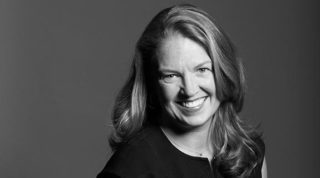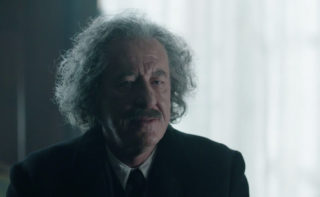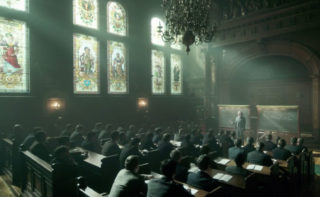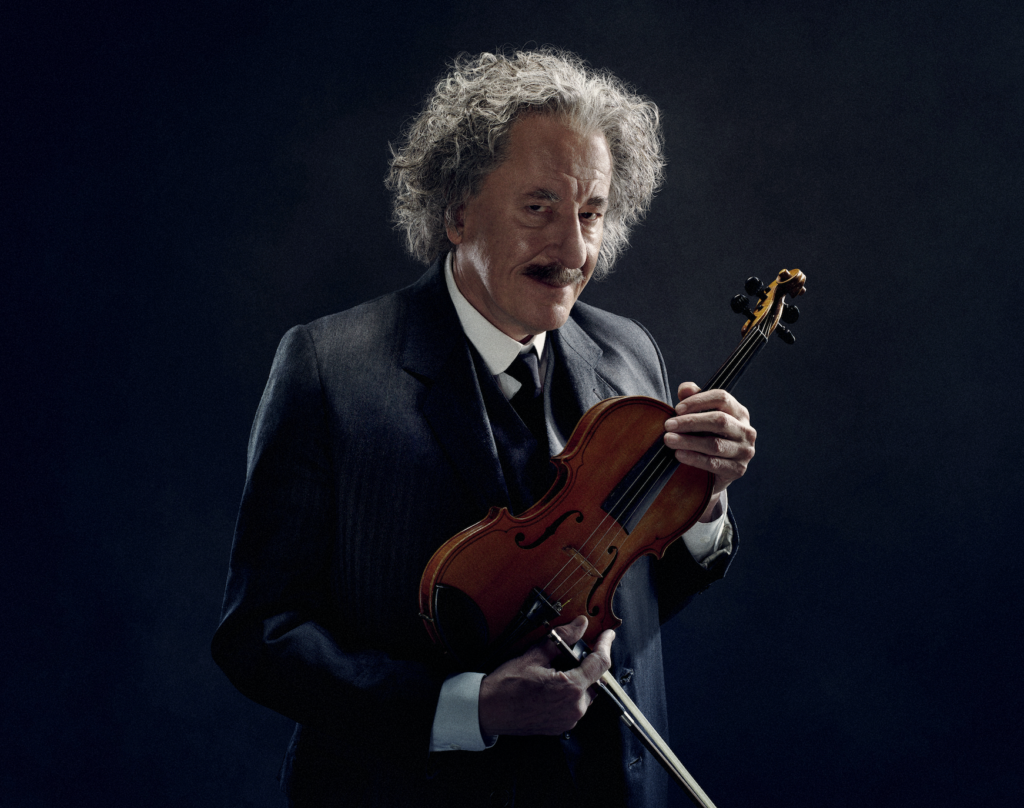National Geographic is unraveling the complicated mysteries of Albert Einstein’s universe with Genius, a 10-part series that looks into the life and times of one of the most brilliant icons of his generation.
Genius, the network’s first-ever fully scripted series, explores Einstein’s extraordinary achievements and reveals his volatile, passionate and complex personal relationships. The series, executive produced by Ron Howard, marries science with a bit of sexy by featuring Einstein’s lovers, enemies and fellow luminaries. The big-budget dramatization is based on acclaimed author Walter Isaacson’s book Einstein: His Life and Universe. The anthology show stars Geoffrey Rush, Johnny Flynn and Emily Watson.
At their Upfront presentation Wednesday in New York, National Geographic announced that Genius already has gotten the green light for season two, which will focus on a different, still-to-revealed iconic figure.
Some of the marketing in recent months to promote Genius was a Super Bowl commercial that was widely considered a smashing success, sponsorships with brands like Viking Cruises and a perfectly timed experiential takeover in Austin for SXSW to celebrate Pi Day and Einstein’s birthday with week-long programming.
Jill Cress, chief marketing officer and executive vice president for National Geographic Partners, leads the marketing mission for a company that reaches over 730 million globally each month through its television channels, magazines, books, studios, digital, social media and children’s media. She joined AListDaily to shed light on how Genius will explore “Further,” their new tagline as the consumer-facing expression of the brand.

What kind of advertising and marketing impact does a cultural icon like Albert Einstein open for a brand?
Albert Einstein was truly an icon and a celebrity of his day. He was a big thinker and a rebel. He also was incredibly promiscuous, and quite the lady’s man. As the series Genius is all about the man behind the mind, our campaign taps into the many dimensions of Albert. We know so much about Albert’s prodigious work in science and his theory of relativity, but it’s his not widely known personal life that we found so fascinating. One of the things we have really tried to do is make the campaign contemporary, so while it is a period piece, the effect with music and style is very edgy. Also, issues that Einstein faced are just as relevant as ones we are facing today. I was on set for a week in Prague and I became obsessed with Einstein. I had this intense desire to learn more about him and his views on life. Also, I was blown away by up-and-coming actor Johnny Flynn’s portrayal of the young Einstein. He brings innocence to this role, coupled with his intensity that really inspired how we wanted to advertise this.
How do you plan on carrying on the marketing momentum for Genius as you get ready for the premiere?
Genius was a comprehensive and integrated four-month global marketing campaign that really kicked off with spots in the Golden Globes and SAG Awards and continued the momentum with our Valentine’s Day spot. We also had local market spots for the Academy Awards, a premiere in London and multiple events in the US maximizing National Geographic’s portfolio of brands. Marketing lived across all media platforms, as well as experiential, PR and strategic partnerships. What’s so great about National Geographic, we can also maximize our existing portfolio of our brands to amplify the series. We wanted to engage viewers globally with this brand-defining, first fully scripted series that tells the dramatic, inspiring and untold story about the life of Albert Einstein.

Why was it critical for National Geographic to be a part of the Super Bowl conversation earlier this year? Aside from the actual show, what brand philosophy did you want to reintroduce?
We were presented with this amazing opportunity to promote the show during one of television’s most watched event. We were able to show a broader audience that we can take a topic like Albert Einstein and make it relevant, timely and create a global conversation around Genius, and the National Geographic brand in general. This was a great way to introduce Albert the man, not just the physicist, showcasing “the man behind the mind.”
Were you surprised how well “Bad Romance” was received, and even winning a Super Clio award?
I think I was more thrilled, than surprised. The Super Bowl is crowded and a very noisy field and we only had less than three weeks from conception to production to air. And we knew we didn’t want to do a trailer—that would’ve been too safe and easy, and we wanted to break through. We wanted to do something simple, yet provocative to get attention and own this moment, and ultimately create a conversation. Not only were we able to successfully tap into the zeitgeist of Lady Gaga’s highly anticipated halftime performance, but we were also able to give a peek into the surprising side of Einstein the series captures. To build awareness throughout the weekend leading into the Super Bowl, we supported the Super Bowl spot with a carefully coordinated communication plan and an extensive push across our social and digital platforms.
How are you leveraging the success to create a global conversation on social around the series? How are you using social data to better connect with consumers? What was your social media marketing strategy that you executed?
The success of the Super Bowl spot was due largely to an extensive push across social and digital platforms. With a fan base of 352 million people across all of our social pages, when we engage with them in a contextual conversation, we see incredible results. Throughout the weekend, we published curated Einstein content to showcase Albert’s love of music and his other passions. In addition, we executed National Geographic social page and handle takeovers with Genius and had fun with in-game tweets touting the physics of football. The tremendous response the spot received was the result of a truly integrated campaign across National Geographic Partners. Since then, we’ve continued to find ways to make this historical genius contextually relevant to issues that our fans and followers care about. In fact, he may have just something to say during our upcoming Earth Day content.

You joined National Geographic late last October. What’s the one big thing you’ve learned on the job so far?
Most immediately I found out that the National Geographic brand has such strong equity and the power of the yellow border is the power of our brand. And at the core of the brand is quality and I’ve seen why it hasn’t been hard to attract A-level talent to work with us. I was fortunate to come into such incredible team already in place at National Geographic, led by Courteney Monroe, CEO of National Geographic Global Networks. I was totally wowed by the passion of the people and the amazing work that they have done to push the boundaries of exploration and making the world a better place. There are powerful stories there that are ripe for being shared in a more emotional way.
How do you see the National Geographic brand strategy evolving this year? How do you plan on taking the brand to new heights?
The National Geographic and the yellow border has been such a revered and iconic brand. What I hope to do is shift the brand from reverence to relevance. The Genius Super Bowl spot was a key opportunity to make Albert Einstein relevant to the Super Bowl. We delivered in a way that was still at its heart National Geographic, but able to tap into the zeitgeist. We hope to launch our new tagline ‘Further’ as the consumer-facing expression of the brand. Inspire people to fall in love with our renewed, forward-thinking brand and build on the insight that your heart will take you further than your mind ever will. Great brands connect at a functional and emotional level and we are bringing more heart to our stories to drive that emotional connection. At National Geographic, every day we are inspired by the determination and insatiable curiosity of our explorers—it’s what pushes us further. But you don’t have to climb to the top of Mount Everest to be an explorer. They are all around us and we hope that the work that we do incubates the next generation of explorers.
The cable and satellite industry is always fluid and shifting. How do you plan to amp up your marketing to reach digital natives and cord cutters? What are the insights and data that influence your marketing strategy? Is there a new product or service that you think will influence decisions?
Consumers are more connected than ever before and even if they aren’t cutting the cord the prevalence of dual and triple screen behavior is real. That can be seen as an opportunity more so than as a threat. This was key to our Super Bowl activation. We are diving into our consumers behavior and mindset in a renewed way to understand how we can meet them where they are. We are thinking digital first and innovating around our products and solutions. We are the No. 1 non-celebrity brand on social media. Our consumers have already told us they want to engage with us a, and now it’s up to us to meet them with the right stories and content. We will be getting more personal with our fans to understand their unique interests and passions so we can be even more relevant to them. Just recently, we launched a more coordinated social conversation around climate change, a topic that we, as well as members of our community, are incredibly passionate about. #MyClimateAction is a way for us to engage that community in a more specific way that empowers them with the science behind climate change.
What is on top of your marketing “hot list” this year? What emerging trends are you zeroing on in order to explore and innovate the brand?
Our big focus will be on the intersection of content, and delivering more personalized content that matters most to our consumers. National Geographic has been inspiring the world, and particularly those with a curious mindset and associated values for 130 years. Our storytelling efforts have inspired and rallied people from all over the world. We can leverage the power of data to understand what matters most to these communities and move from broad storytelling to story-making platforms. With digital content, we can bring the power of our explorers and their work and passion to an audience in incredibly powerful and personal ways. We will also be starting more conversations with our communities to learn more about what they want, and their views on what matters, so we can continue to be as relevant as we’ve ever been.
Follow Manouk Akopyan on Twitter @Manouk_Akopyan

